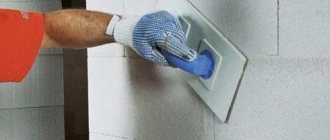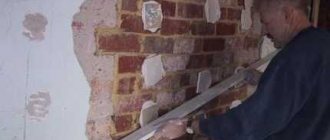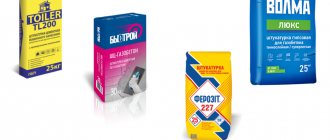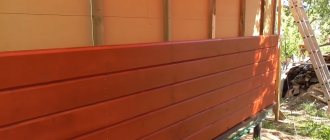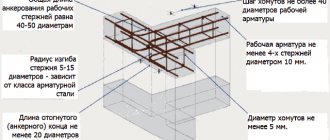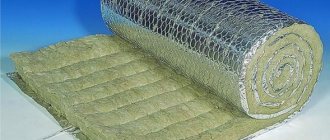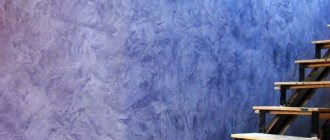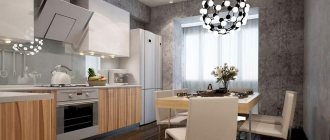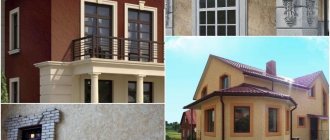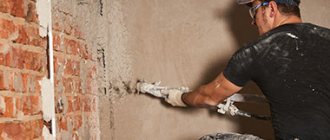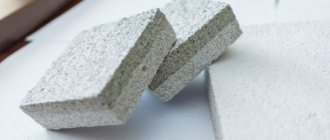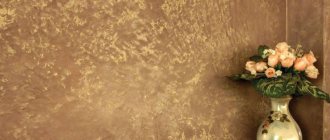- Plaster
- How to correctly calculate plaster consumption
- KNAUF ROTBAND
The finishing coating applied to cellular concrete masonry, in addition to providing an aesthetic appearance, also has protective functions. It insulates the masonry surface from mechanical damage and waterlogging, and reduces the likelihood of blowing through the walls to zero. The standard for finishing aerated concrete walls imposes certain requirements on vapor permeability, frost resistance, water absorption and adhesion. According to the unanimous opinion of experts, aerated concrete plaster is considered the best material that meets all these requirements at once. Why? You will learn about this by reading the material presented here.
Basic requirements for plaster
It is worth noting right away that it is not recommended to apply ordinary plaster to a house made of aerated concrete blocks. Primarily because standard sand solutions are high-density, this leads to poor adhesion when applied to aerated concrete blocks and the rapid appearance of cracks.
Adhesion (from Latin adhaesio - sticking) in physics is the adhesion of the surfaces of dissimilar solids and/or liquids.
The plaster should maintain an optimal microclimate inside the building, protecting the walls from moisture. Therefore, you should choose mixtures with a vapor-permeable base. Otherwise, the steam coming out of the house will get stuck inside the walls, since the plaster will simply block its exit to the outside. Thus, moisture will begin to accumulate in the walls, which will ultimately lead to their destruction. Of course, nothing will happen to the house in a few years, but in six to eight years, an almost irreversible process of destruction will begin.
Plaster for aerated concrete should be:
- resistant to external weather influences;
- have good adhesion (adhesion to aerated concrete);
- resistant to sudden temperature changes;
- high degree of compressive strength (protection against cracking);
- vapor permeable;
- moderately dense;
- improving the thermal insulation of walls;
- have a decorative appearance.
When choosing plaster for aerated concrete, you should not ignore any of the points listed above.
Applying plaster to a house made of aerated concrete blocks Source emupauto.ru
The absence of facade finishing of aerated concrete structures will lead to darkening, deformation, and peeling of the surfaces of the blocks.
Promotes vapor permeability of walls
The components contained in aerated concrete contribute to the vapor permeability of the building material. However, this factor requires the selection of a certain composition of mixtures for carrying out repair and finishing work on the walls of the building. To do this, it is necessary to carry out plastering in such a way that the inner wall is vapor permeable or, on the contrary, vapor barrier. In a house with such a wall, the microclimate will self-regulate. In addition, fungi or mold will not grow in the wall.
Return to contents
Types of plasters suitable for aerated concrete blocks
The choice of plaster mixture for aerated concrete primarily depends on whether you are going to cladding the walls from the outside or from the inside. Based on the type of application, plasters are divided into external and internal.
As you understand, external plaster is intended for finishing facades. Since here it performs protective functions, its strength, moisture resistance and thermal insulation indicators should be higher.
Internal mixtures are intended for finishing indoor walls, so the presence of moisture resistance in the characteristics of these plasters can be ignored, with the exception of cases of wall cladding in the bathroom. Due to the lack of resistance to moisture, internal mixtures are much cheaper than external ones.
Applying a finishing layer of plaster to aerated concrete Source o-cemente.info
Popular plasters for aerated concrete
Mixtures for finishing facades made of aerated blocks are divided according to the type of composition into:
- lime-cement;
- cement thermal insulation (less than 500 kg/m3);
- acrylic;
- silicate;
- silicone.
Lime-cement mortars are quite durable and at the same time vapor-permeable, because their main component is lime, which replaces sand. This type of plaster is popular due to its low cost. So if your task is to make a budget cosmetic repair of the facade or finish the basement, this option is suitable.
Cement heat-insulating (less than 500 kg/m3) mixtures, as a rule, are porous when hardened, lightweight (about 4 kg/m2 with a layer thickness of 10 mm, for comparison, heavy ones can weigh 20-30 kg/m2), and are characterized by high vapor permeability (0.2 ), belong to the class of hydrophobic, weather-resistant and, as a bonus, thermal insulation. This type of mixture is able to protect the house from freezing, blowing, moisture, and the service life of such plaster is comparable to the service life of the entire building. Single-layer cement mixtures for facades are a good solution from the point of view of “sufficiently reasonable” investments and performance characteristics. However, it is necessary to pay attention to the composition, as not all fillers of such mixtures correspond to the declared characteristics and may turn out to be hygroscopic (absorb moisture), which will lead to rapid destruction of the plaster layer. Hygroscopic materials include: perlite, vermiculite. Hydrophobic materials include foam glass and ceramic foam. Of course, the ready-made dry mixture must be of factory origin, comply with GOST 33083-2014, it will be possible to prepare such a composition yourself in a garage, but it will not be possible to achieve high performance characteristics.
an acrylic mixture on the plinth; if you choose it for finishing a facade made of aerated concrete, then be prepared for the fact that in 8-10 years the facade will need to be completely renewed. Since the life of acrylic polymer plaster is maximum 10 years. Such plaster cannot boast of good vapor permeability, moisture resistance and elasticity.
Silicate plaster for aerated concrete is produced on the basis of liquid potassium glass. The coating has good moisture resistance, vapor permeability and durability. The silicate solution is easy to apply. The finishing layer is resistant to dirt and abrasion, providing a decorative finish for a long time (more than 25 years). The problem with silicates is the limited choice of colors.
Leveling walls with silicate plaster Source lineyka.net
Silicone polymer plaster contains acrylic and silicone copolymers. Which make the plaster what it is. The quality characteristics of the material are optimal for creating a durable coating. Silicone plaster has one of the best elastic properties, which ensures the absence of cracks on the surface even when the blocks shrink.
Silicone plaster can undoubtedly be called a leader among others; it has all the most important properties that facade plaster should have, which guarantees you a beautiful and durable facade for many years.
It is not recommended to plaster structures made of aerated blocks using cement-sand mixtures. They do not fit well on the surface of aerated concrete and crack over time.
See also: Catalog of companies that specialize in finishing materials.
Most popular manufacturers
The building materials market is saturated with a huge number of plaster mixtures of various brands for finishing aerated concrete surfaces. Popular compositions have optimal characteristics for the work.
Applying plaster to the interior walls of a house made of aerated blocks Source obustroeno.com
Ceresit CT 24. The mineral composition of the mixture gives the solution plasticity. The material is easy to apply. The coating can withstand up to 100 cycles of low temperature influences. It is recommended to paint after complete drying (after seven days).
CERESIT ST 77. The acrylic type of the mixture is used for facade finishing, ensuring the strength of the coating with a fairly thin layer of application. The material is frost-resistant and resistant to external influences. Used when there is waterproofing and ventilation inside the house.
SPADAR M400 is a cement mixture with the addition of ceramic foam granules, it is a type of single-layer ultra-light plaster mixtures, it is highly decorative, when hardened it is white, according to its technical characteristics it is ideal for plastering walls made of aerated concrete blocks, it is characterized by high adhesion, vapor permeability and does not require priming or the use of reinforcing mesh along the plane of the facade. Weather-resistant, environmentally friendly, non-flammable, durable material.
Founded by Startwell T-21. Cement-lime plaster is frost-resistant and has a sufficient level of adhesion. The resulting coating is resistant to shrinkage and moisture.
Maintaining moisture balance
Considering all of the above, it is important to achieve a balance of humidity in the premises within the standards. Accumulated water vapor must be removed. For this purpose, plastering of aerated concrete walls indoors is done with special materials that are capable of absorbing moisture accumulated in the premises. The most acceptable options involve the use of special plaster and putty mixtures. But when choosing a finish, you should remember that the vapor permeability indicator of each layer should be as close as possible to the cellular blocks.
Building codes regulate the vapor permeability indicator, which indicates the ability of the composition applied to the wall to resist the penetration of water vapor into its structure. The vapor permeability coefficient, measured in mg/(m.h.Pa), shows how much moisture can penetrate within 1 hour through a wall with an area of 1 sq. m. and 1 meter thick, provided that the pressure difference from the outside and inside is 1 Pa.
Video description
Watch the video comparison of facade plasters for aerated concrete:
Farbe silicone plaster. It has one of the best price-quality ratios on the market. The plaster has a high vapor permeability coefficient - 0.035 mg/m2 h Pa. It can be tinted in 2500 colors, that is, you apply a mixture already tinted in the desired color to the façade. The plaster is resistant to atmospheric influences - due to computer tinting, the color retains its saturation for many years. It is worth noting that the plaster is impact-resistant and also environmentally friendly. Sold in two textures: “Lamb” and “Bark Beetle”.
Video description
For detailed video instructions on applying Farbe silicone plaster, watch the following video:
The company also provides the opportunity to order free samples of Farbe plaster - this will speed up the process of selecting colors for the facade, and will also help you verify the quality of these products.
Silicone facade plaster “Bark beetle” and “Lamb” Source myfarbe.ru
Baumit Silicone Top. A high level of adhesion and ductility is achieved thanks to the base of the mixture - silicone resins. The coating remains decorative for a long time due to its dirt-repellent properties. Wide choice of material color palette (up to two hundred shades).
Weber.pas silicone. Mixture based on silicone emulsion. It is possible to select the appropriate grain size. Optimal resistance of the material to moisture, temperature, and dirt.
Baumit Silikat Top. Silicate type of plaster. The coating is durable and has good vapor permeability. The composition has different grain sizes and up to two hundred tinting variations.
Primer of the surface before plastering Source en.aviarydecor.com
Plastering
The plastering process may seem quite complicated for beginners, so it is better to find the best options for work and resolve all issues before starting the process.
How to plaster aerated concrete inside a house
The ideal option would be a gypsum base with the possible addition of various fractions to the composition. For example:
- sand;
- cement;
- lime;
- filler.
Important! When choosing a gypsum composition, keep in mind that it is several times more difficult and problematic to work with than a cement base.
Necessary tool
Before starting work, it is worth preparing a number of tools that will definitely come in handy during the work process. The builder should purchase:
- stepladder;
- container for soil;
- roller or paint brush;
- roulette;
- rule;
- chisel;
- container for diluting the composition;
- trowel;
- putty knife;
- grater;
- falcon;
- screwdriver;
- scissors for metal material.
You also need to prepare shovels and water in order to mix the material.
Attention! To calculate the material, you need to multiply the area by the thickness of the plaster layer. It is better to take with a reserve of 15-20%.
Internal plaster of aerated concrete walls
Internal work on plastering walls made of aerated blocks is carried out with gypsum solutions with various additives. Composites in the form of perlite and marble chips will increase the decorative effect of the finish. There is the possibility of painting the composition in various colors.
Gypsum mixtures without additives have the required level of vapor permeability, which allows the plaster to be used as a base for wallpapering. Standard sequence of work:
- elimination of irregularities and chips on the surface of the walls;
- removing dust and applying the first layer of solution;
- installation of reinforcing mesh;
- applying the second layer.
After complete drying, you can glue wallpaper, paint the walls, or apply a third, decorative layer of plaster.
Interior work is carried out only subject to the preliminary application of a waterproofing compound and priming.
Interior wall plaster Source poradnuk.com
Subtleties of the workflow
To achieve greater vapor permeability when finishing aerated blocks, you can use plasterboard panels. It must be taken into account that, according to the approved rules, it is impossible to finish the building on the inside with vapor-permeable building materials, and on the outside with vapor-proof materials. The durability and reliability of the finish will directly depend on how high-quality materials are used in construction and finishing. According to experts, even high-quality plaster is unlikely to adhere to low-quality aerated concrete.
Builders also advise using the following useful tips:
- When driving nails, the plaster will crumble if there is no wallpaper on the walls. You can avoid this if you apply adhesive tape to the place where the nail will be hammered.
- If the plaster layer lags behind, it can be further strengthened. It is necessary to drill several holes in the layer, then pour in glue using a syringe and secure the plywood on top.
- Before sealing the holes with plaster mortar, it is necessary to drive several nails around the perimeter. This patch will be more reliable.
External plastering of aerated concrete walls
Plaster for façade aerated concrete can be applied using various technologies: thick-layer or thin-layer finishing. The sequence of work includes:
- mandatory preparation of wall surfaces, leveling;
- priming (compositions based on acrylate siloxane);
- applying a thin layer of solution - the basis for attaching the mesh;
- reinforcement (protection against cracks);
- leveling the finishing layer;
- second layer of coating (formation of a smooth, even surface);
- finishing layer of plaster, grout.
A year after completion of the facing work, it is recommended to apply a water-repellent solution. Thanks to the treatment of the facade with this composition, the moisture-proof and water-repellent properties of the coating are increased.
Lightweight single-layer plaster for aerated concrete is easy to apply with relatively heavy mixtures. The sequence of work includes:
- preparing the surface of the walls by removing dust and moistening the surface with a brush and clean water;
- applying a leveling layer of 5-10 mm (allowed both with and without beacons);
- applying a textured, finishing layer of plaster 5 mm, forming the texture using plastic graters;
- Painting is not necessary, but can be done with vapor-permeable paints if desired.
Video description
Watch the video of the process of applying plaster to a house made of aerated concrete:
It is also important to remember the rule of increasing the degree of vapor permeability from the inner layer to the outer surface. The façade finish should be twice as thin as the interior coating.
Plastering on a reinforcing mesh Source bg.decoratex.biz
It is strictly not recommended to carry out plastering work on aerated block surfaces earlier than 6 months after the construction of the walls. The structure must dry completely, getting rid of excess moisture accumulated during laying of the material.
Advantages and disadvantages
Gas silicate is often called aerated concrete. This is not entirely correct. The difference between them is insignificant. In aerated concrete, the main binding element is Portland cement, while in aerated silicate it is lime. The second block will appear lighter than the first. There are slight differences in technical specifications. However, they are not of a fundamental nature.
The popularity of gas silicate is explained by a number of its advantages.
- The aerated block has a low price, which can significantly reduce the cost of construction.
- It is light in weight. If you compare gas silicate and concrete blocks of the same size, the first will weigh five times less than the second. This allows you to make a less powerful foundation, and therefore also reduce costs.
- Gas silicate has low thermal conductivity. They are eight times lower than that of brick. Therefore, the material is often used in countries with cold climates.
- It has high soundproofing qualities.
- GSB allows steam to pass through well.
- Gas silicate is safe from an environmental point of view.
- The blocks are produced with strict linear shapes, which speeds up their laying.
